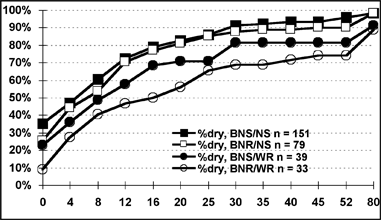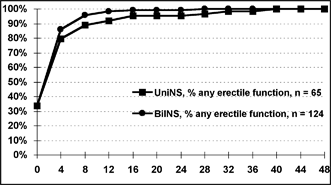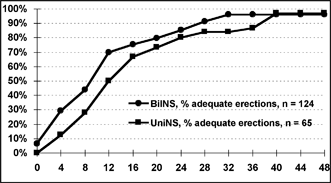- Home
- About Dr. Harris
- Urologic Conditions
-
Clinic Hours:
Monday - Friday: 8 - 5pm
with a lunch break

Dr. Harris has performed over 1700 radical perineal prostatectomies (RPP) for 'clinically localized' prostate cancer in the past 30 years. While about 250 cases were for locally advanced cancers, radiation resistant cancers or patients operated on as a visiting professor, 765 radical perineal prostatectomies were performed in Traverse City for 'clinically localized' prostate cancer. The outcomes database at Northern Institute of Urology is prospectively accumulated and updated daily. The following data are being published in various peer-reviewed urologic journals in the Unites States and Europe. These data represent Dr. Harris's personal surgical experience over the past 15 years.
Cancer control: Undetectable PSA is the ultimate goal of prostate cancer treatment. However, clean surgical margins are the cancer-specific goals of RPP, as some men present with more advanced disease than initially realized. The average tumor size is 7.3 grams. Positive margins are seen 16.4% of cases without seminal vesicle invasion (seminal vesical invasion (SVI) is associated with higher risk of recurrence than positive margins (18.9% if SVI included). Margins are considered 'focally positive' (less than 1 mm2) in 9.9% and 'non-focal' or multiple in 8.9.%. Follow up ranges from 3 months to 15 years. Data presented are 3, 5 & 7 - year minimal actual follow up. When comparing cancer results, it is important to understand the make up of the patient groups being compared.
| PATHOLOGIC STAGE | GRADE | N | PSA | CAsize grams |
3YR, PSA=0 | 5YR, PA=0 | 7YR, PA=0 | |||
| N | N | N | ||||||||
| ORGAN CONFINED |
2-6 | 302 | 9.7 | 4.9 | 230 | 97.4% | 184 | 97.3% | 80 | 93.8% |
| 7-10 | 241 | 5.6 | 7.4 | 155 | 96.1% | 118 | 95.8% | 43 | 88.4% | |
| ALL | 543 | 7.9 | 6.0 | 385 | 96.9% | 302 | 96.7% | 123 | 91.9% | |
| SPECIMEN CONFINED |
2-6 | 28 | 7.4 | 10.6 | 27 | 85.2% | 21 | 81.0% | 15 | 73.3% |
| 7-10 | 61 | 6.7 | 9.1 | 45 | 77.8% | 34 | 67.6% | 15 | 40.0% | |
| ALL | 89 | 6.9 | 9.6 | 72 | 80.6% | 55 | 72.7% | 30 | 56.7% | |
| FOCAL POSITIVE MARGIN |
2-6 | 26 | 6.0 | 5.7 | 23 | 91.3% | 17 | 82.4% | 9 | 77.8% |
| 7-10 | 44 | 7.3 | 8.4 | 36 | 88.9% | 25 | 80.0% | 17 | 70.6% | |
| ALL | 70 | 6.8 | 7.4 | 59 | 89.8% | 42 | 81.0% | 26 | 73.1% | |
| NON-FOCAL POSITIVE MARGIN |
2-6 | 22 | 6.8 | 8.7 | 21 | 57.1% | 18 | 44.4% | 13 | 30.8% |
| 7-10 | 42 | 7.7 | 8.8 | 30 | 53.3% | 25 | 48.0% | 15 | 46.7% | |
| ALL | 64 | 7.4 | 8.8 | 51 | 54.9% | 43 | 46.5% | 28 | 39.3% | |
| SEMINAL VESICLE INVASION |
2-6 | 3 | 7.1 | 24.1 | 3 | 66.7% | 3 | 66.7% | 1 | 100.0% |
| 7-10 | 31 | 8.1 | 19.3 | 25 | 28.0% | 21 | 19.0% | 14 | 14.3% | |
| ALL | 34 | 8.0 | 19.7 | 28 | 32.1% | 24 | 25.0% | 15 | 20.0% | |
| OCCULT METASTATIC CANCER |
2-6 | 0 | 0 | 0 | 0 | 0.0% | 0 | 0.0% | 0 | 0.0% |
| 7-10 | 5 | 14.3 | 11.3 | 5 | 0.0% | 5 | 0.0% | 5 | 0.0% | |
| ALL | 5 | 14.3 | 11.3 | 5 | 0.0% | 5 | 0.0% | 5 | 0.0% | |
| TOTAL | 2-6 | 381 | 304 | 92.8% | 243 | 90.5% | 118 | 83.1% | ||
| 7-10 | 423 | 296 | 80.7% | 228 | 75.4% | 109 | 59.6% | |||
| ALL | 805 | 6.0 | 7.3 | 600 | 86.8% | 471 | 83.2% | 227 | 71.4% | |
Urinary continence: The techniques used to reconstruct the urethra after the prostate is removed have evolved over the 15 years of this data. Since January 2002, a more advanced suture method is utilized resulting in dramatic improvement in urinary control. Today, the catheter is removed 8 days after surgery. 'Socially dry' refers to men who are essentially dry, but use no more than one pad in 24 hours for protection. 'Totally dry' refers to men who are confidently dry and do not wear pads. The graph shows the percent of men 'Socially dry' and 'Totally dry' in weeks after catheter removal.

The following graph compares the time to full urinary control (no pads) in weeks after catheter removal in men with or without erectile nerve preservation and bladder neck preservation (versus reconstruction). The men with at least one erectile nerve bundle spared and preservation of an intact bladder neck have the best results. Tumor characteristics and prostate anatomy influence whether nerves and/or bladder neck preservation is possible. (BNS: Bladder neck spared, BNR: Bladder neck reconstructed, NS: Nerves spared, WR: Wide resection (non-nerve spare).

Return of erectile function: Preservation of erectile nerves is considered in men with good erectile function and a very low risk of compromising cancer control by performing a 'less than radical' prostatectomy. In the summer of 2001, Dr. Harris significantly revised the technique of nerve preservation during radical perineal prostatectomy. This new technique has provided better results than those obtained in past years. The following results represent the past 5 years of unilateral (one nerve bundle) and bilateral (both nerve bundles) cavernosal erectile nerve preservation. 'Partial erections' refer to those erections that can be obtained by erotic stimulation but are not adequate for penetration. 'Adequate erections' are those capable of completing intercourse with or without the use of Viagra, Levitra or Cialis. While it is nice to preserve erectile function, the first consideration should focus on curing prostate cancer with an adequate resection of a sufficient margin around the prostate gland. The erectile nerves are right on the surface of the prostate, therefore, there is no margin for safety in cases of superficial tumors or cancers that have infiltrated just outside the confines of the prostate gland.


Complications: Strictures (scar tissue) can develop at the bladder neck or in the urethra (<1%), requiring outpatient dilation. One blood transfusions has been given in the past 1200 cases. As a result, blood banking in advance of surgery is not necessary. Most men are home on the day after their 80-100 minute surgery. Many patients do not feel it necessary to take pain medication following discharge home. The catheter is removed in 8 days and the patients are unrestricted in their activity (except bicycle riding for several months). One man has experienced anal incompetence, while 2-4% note mild fecal urgency or flatus with coughing. One person had a transient ischemic attack and another had a mild stroke on the day of after surgery, both have fully recovered. We have seen one heart attack in an uncomplicated recovery period that appears to have been coincidental to his prostatectomy. No deaths or lung problems have arisen.
Cost issues: With increased medical technology driving up the costs of care in medicine, the RPP remains far more affordable than any other management option, surgical or radiation. Short operating room time, no expensive technologies and an overnight stay keep total hospital charges a fraction of the cost for robotic, laparoscopic, retropubic prostatectomies or radiation options at other centers of excellence. By avoiding the use of a robot and the associated loss of tactile sensation, the tremendous cost of this system is also avoided. The best robotic prostatectomy series approach the good outcomes consistently achieved with nerve sparing radical perineal prostatectomy. Time away from work varies from 2 to 4 weeks depending upon the type of work.
Comment: While radical prostatectomy is the most effective treatment of localized prostate cancer, the nerve sparing anatomical radical perineal prostatectomy is the most 'patient-friendly' method of curing prostate cancer.